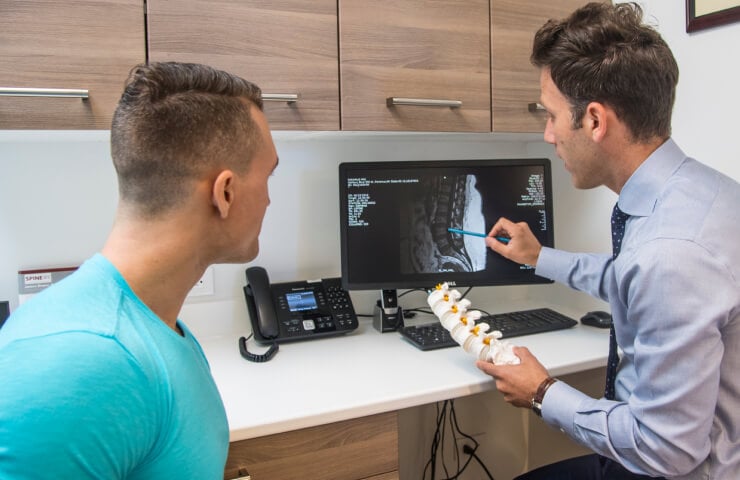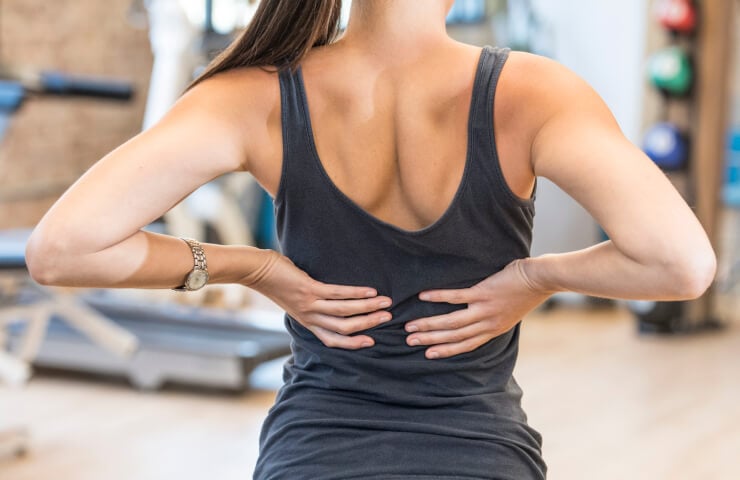Hip & Pelvis Conditions
Together, the pelvic bones and hip joint form the starting point of the lower half of the body. They make it possible for you to carry out many kinds of dynamic movements, including walking, running, and jumping. They also support the weight of your body. The hip and pelvis are supported by muscles, ligaments, tendons, and cartilage. Disease or injury to the hip or pelvis can make everyday activities such as taking a walk or getting up from a chair painful.
All Hip & Pelvic Conditions
- Ankylosing Spondylitis
- Avascular Necrosis (Osteonecrosis)
- Broken Hip
- Dislocated Hip
- Femoroacetabular Impingement
- Greater Trochanter Bursitis
- Hamstring Strain/Sprain
- Hip Arthritis
- Hip Bursitis
- Hip Fracture
- Hip Labral Tear
- Hip Osteoarthritis
- Hip Pain/Injury
- Hip Sprain/Strain
- Hip Tendonitis
- Irritable Hip Syndrome
- Piriformis Syndrome
- Post-herniorrhaphy Pain
- Rheumatoid Arthritis
- Rib Pain
- Sacroilitis
- Sciatica (Sciatic Nerve Pain)
- Slipped Capital Femoral Epiphysis
- Snapping Hip Syndrome
- Soft Tissue / Referred Hip Pain
- Sports Injuries
- Trochanteric Bursitis
Get Advanced Hip Care
Right In Your Neighborhood
Finding the treatment that’s right for your hip problem is our focus at The Orthopedic Health Center. We use non-surgical treatments whenever possible. When you do need surgery, our expert surgeons help you heal faster and with less pain. All right in your neighborhood: Hoboken, Jersey City, or Bayonne,.
Anatomy of the Hip and Pelvis
The pelvis is located at the base of the spine and above the legs. The main bones of the pelvis include:
- The hip bones: a pair of large flat bones that somewhat resemble a pair of open butterfly wings
- The sacrum: a large triangular bone located at the base of the spine
- The coccyx: also known as the tailbone, the coccyx is the last segment in the spinal column
- The pubis: also known as the pubic bone, the pubis is located in the front region of the pelvis
The pelvis also contains several joints:
- The sacroiliac joint, which connects the hip bones to the sacrum
- The sacrococcygeal joint, which connects the sacrum to the coccyx
- The symphysis pubis joint, which supports the pubis
The pelvis provides structural stability to the central and lower portions of the skeleton and serves as a connecting point for some of the strongest muscles in the body. It also protects and supports several internal organs, including the intestines, internal sex organs, and the bladder.
The pelvis connects to the femur through the hip joint, which is a ball and socket joint. The hip helps to bear the weight of our bodies while also supporting articulation of the lower body.
Muscles of the Hip and Pelvis
Muscles are tissues that enable the hip and pelvis to move while also providing support for your body. The primary muscle group of the pelvis is known as the pelvic floor muscles, which are located between the coccyx and the pubic bone. The main pelvic floor muscles are known as the levator ani, which includes three pairs of muscles:
- The iliococcygeus
- The pubococcygeus
- The puborectalis
The hip joint consists of many different muscles that are grouped together based on function. These muscles include:
- Abductors, which allow us to move our legs out to the side
- Adductors, which allow us to bring our legs together
- Flexors, which allow us to push our legs forward at the hip
- Extensors, which allow us to push the leg back towards the body
- Internal and external rotators, which allow us to swivel the leg at the hip
Other Tissues in the Hip and Pelvis
The hip and pelvis are also supported by several ligaments. Ligaments are tough bands of tissue that connect bones to each other or cartilage. They provide support, stability, and strength to the musculoskeletal system.
The hip joint consists of two different categories of ligaments – the intracapsular and extracapsular. The intracapsular ligament connects the head of the femur to the capsule of the hip joint. The extracapsular ligaments of the hip joint include:
- The iliofemoral ligament, which connects the femur to the anterior of the hip joint and keeps the hip from overextending
- The ischiofemoral ligament, which helps to prevent excessive extension
- The pubofemoral ligament, which is a small triangular ligament that reinforces the hip capsule and prevents overextension and abduction
The ligaments of the pelvis include:
- The pubic symphysis ligaments, which provides weight-bearing support
- The inguinal ligament, which provides support for the groin area and stability to the pelvis and abdomen
- The sacroiliac ligaments, which are three ligaments that hold the sacroiliac joint together
- The iliolumbar ligament, which supports the lower lumbar spine
- The lateral lumbosacral ligament, which helps to stabilize the spine on the pelvis
- The sacrococcygeal ligaments, which support the sacrococcygeal joint
The hip and pelvis also contain several tendons and cartilages. Tendons are tough yet flexible cords of tissue that connect muscle to bone. Cartilage is the tough yet flexible tissue that covers the ends of your bones at the hip joint. It helps the hip move smoothly and cushions and protects it.
Hip and Pelvis Pain FAQ
A: Hip pain is a very common complaint that patients have. The earliest signs that you may have a chronic hip issue are stiffness, pain, swelling, difficulty bending at the hip, and limping. These symptoms can vary from case to case in terms of severity and will ultimately be dependent on what is specifically causing the issue. While these symptoms may go away on their own or with self-care, you should definitely consider seeing an orthopedic specialist if your hip pain persists or gets worse.
A: Orthopedic treatment options for hip pain are varied, ranging from noninvasive to surgical. Orthopedic doctors are also surgeons who can provide surgical intervention for hip pain when necessary. However, many orthopedic specialists try to take a conservative approach towards treatment and only rely on orthopedic hip surgery when all other forms of care have been unsuccessful.
A: If your pelvis is broken, your ability to move, walk, or sit will be severely limited. Other symptoms of a broken or fractured pelvis include pain in the lower back and groin. If you’re experiencing pain in your pelvic area but are able to walk relatively unencumbered, it’s unlikely that you have fractured your pelvis.
A: In some cases, hip and pelvic pain can be easily managed at home with self-care. Some common forms of self-care for hip and pelvic pain include gentle stretching, applying an ice bag, taking a hot bath or shower, using over-the-counter medications, and resting. However, if your pain continues to get worse, consider scheduling an appointment with an orthopedic doctor that specializes in hip and pelvic pain as soon as possible.
The Most Advanced Surgical Techniques
Take a closer look at the level of care to expect at The Orthopedic Health Center.
Hip and Pelvis Pain: Sprains, Tears, and Fractures
With many bones, muscles, ligaments, and tendons, the hip and pelvis are susceptible to a wide range of injuries. Some of the most common causes of hip pain include fracture, labral tears, tendinitis, and bursitis, all of which typically occur as a result of overuse during exercise or sports. Hip pain is also commonly caused by arthritis and general wear and tear. Pelvic pain can be caused by musculoskeletal issues. However, because the pelvis supports so many internal organs, there are several other conditions that can contribute to pelvic pain, especially in women.
Comprehensive Orthopedic Care for Hip and Pelvis Pain
Some of our treatment options for hip and pelvis pain includes:
Edward Feliciano, MD
Director of Orthopedic Surgery
Edward Feliciano, MD is a board-certified orthopedic surgeon and the Director of Orthopedic Surgery with training from Yale, Cornell and Georgetown University.
Appointments available now.















